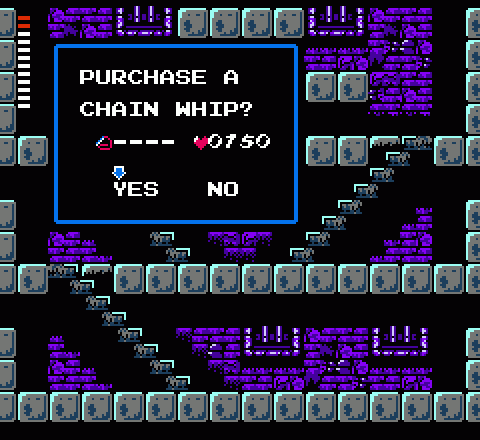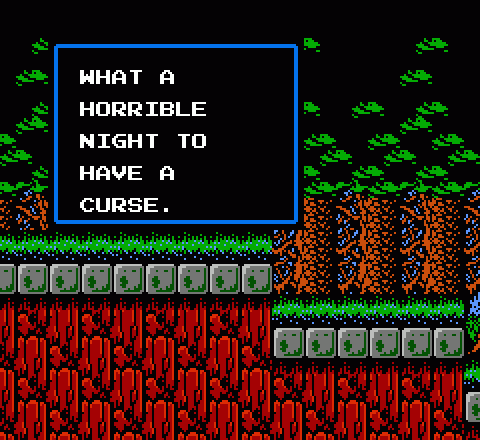Simon’s Quest works, by and large, like Castlevania. You control Simon Belmont. He walks (hobbles) along, whips stuff, uses subweapons, jumps, gets knocked back into pits when he collides with enemies, and seeks to destroy Dracula. The general details are almost indistinguishable at a glance, except now Simon wears dark armor instead of leather.
Take a closer look, however, and you’ll find quite a few differences. For starters, the original whip upgrade system has gone right out the window. Powering up the Vampire Killer took all of about 10 seconds in most cases in Castlevania, and the second- and third-stage upgrades would be revoked upon death. Not here: Simon begins with the weak leather whip, but once he acquires an upgrade it’s permanent. The trade-off is that upgrades no longer simply drop from candles or enemies. No, now you have to buy them. With cash money. And by “cash money” I mean “hearts.”

This makes an insane amount of sense, actually. Hearts served as currency in the first game, too, but the “economy” there revolved entirely around spending hearts for subweapons. Simon’s Quest expands the number of things you need to “buy” and therefore adjusts the way hearts work, slightly. The game no longer provides candles for farming random drops; now, you can only gather hearts from enemies. (This also earns you experience points, unless you’ve exceeded the current area’s level threshold.) On the plus side, enemies don’t just drop single hearts. Multiple-heart drops appear pretty often, usually from tougher foes. So, you kill bad guys, collect hearts, and buy stuff that you keep forever (except stakes, which have to be purchased anew in each Mansion). Upgrade the Vampire Killer to a thorn whip, it’s a thorn whip forever. Get the flame whip and you will always be able to burn away bad guys with fire. Forever!
As I mentioned before, an invisible time limit counterbalances the temptation to grind for cash. It’s awfully tempting, in that very first town, to duck outside and whip dudes until you can afford a crystal and a whip upgrade (play efficiently enough and you can scrape up just enough to buy them before business closes for the night), but if you spend too much time doing that the in-game clock will turn over and you’ll get a worse ending. Or “worse” ending; more on that sometime later. I don’t think there’s any in-game indication that you’re on a schedule, but the day/night cycle does hint at it.

Yes, a diurnal cycle. I can’t imagine Simon’s Quest is the first game to include day and night, though the only prior instances that come to mind are adventure games and RPGs. Ultima III had its moongate system, for instance. But action games? I think Castlevania may well have been an innovator on that front. Day turns to night and vice-versa, each time with a memorable snippet of text, at 6:00 on the dot. Monsters become twice as powerful at night — “powerful” in this case meaning they become twice as hard to destroy — and villagers close their doors. Aside from the handful of free-roaming NPCs in the wilderness and folks in Mansions, you’re basically locked away from character interaction between the hours of 6 p.m. and 6 a.m. This, more than the amped-up hostility of the bad guys, makes nighttime in Simon’s Quest feel lonely and intimidating.
The overall time limitation combined with the go-anywhere feel of the world and the steady march of day/night transitions creates what is, by far, Simon’s Quest‘s most compelling feature. The overall difficult level may skew low thanks to the too-forgiving continue system and laughable bosses, but the game nevertheless creates a sense of tension. Do you press on toward the next goal despite not having the calibre of equipment you’d prefer? Do you lurk near the entrance to town as sunset nears or sunrise approaches, or do you go about your business? Again, the way time stops ticking once you enter a Mansion does undermine this risk/reward mechanic somewhat, but the sense of safety and empowerment that cities offer makes delving into the far reaches of the Transylvanian wilderness an occasionally daunting task — not unlike venturing far from town in a game like Etrian Odyssey or Wizardry. It’s interesting that when people talk about how Simon’s Quest resembles an RPG they’re usually speaking of the light leveling mechanics or cursory inventory system, when in fact the game draws upon RPG influences in much deeper and more subtle ways.
I’ll never forgive you if you make me love this game.
I’d always been told by many people that Simon’s Quest, for some bizarre reason, actually gives you worse endings for completing the game quickly. Is that a lie? Are they secretly CV2 villagers?
@Guy: That is not wrong. I will get to that later.
As memorable as the text transition is, it can be the slightest bit awkward how the game freezes the action for a few seconds every time it goes from day to night or vice versa. But still, the game had a day/night system long before that was a thing outside of the RPG genre.
When most NES games had a change from day to night, it was only because that particular stage or area takes place at night. In CV2, night foes on the field are sturdier but more rewarding on the hearts front, and the towns all become Zombieville until morning hits. Coupled with the effect time has on the ending (that the game never actually tells you about), it’s a pretty nifty mechanic for a game of its age.
Of course, being a game that uses passwords, you can exploit those to get the ending you want instead of taking advantage of mansion time freezes. It’s very handy if you want to see the “””””best””””” *cough cough* ending.
The weirdo endings are quite liberating in a way. There’s very little pressure to grind or not grind when you realize the endings are totally mixed up and you’re actually punished for trying to beat the game in the quickest “game time” possible.
@MMM I think by “it can be the slightest bit awkward how the game freezes the action for a few seconds” you mean it is awesome to try to freeze Simon in dashing poses as day turns into night.
This was always one of my favorite NES games. I honestly wish Konami would remake it - it feels like a prototype for the “Metroidvania” style games like Symphony. A remake could benefit so much from the innovations the newer Castlevanias have brought to that style. And you know, have more than three bosses
Re: the last paragraph. I’d never thought about the day/night cycle that way before.
Aaaaaand that’s why I’m a Jeremy Parish fan.